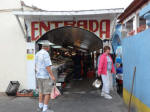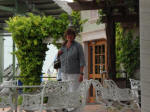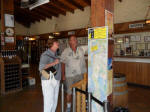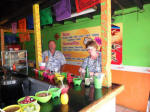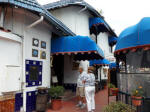March on the beach. We love to stay in our favorite little cabin perched right on the beach.
We had come this time, to help our friend Zana prepare his puesto for the upcoming Semana Santa, Easter celebration, a very busy time in his humble beach cafe. When we found him, (accidentally) he was scouring our beloved little fishing village for banana leaves. "Are there any growing at Islandia?" he wanted to know. We set out back to the humble "resort" where we have stayed for more than 35 years to see if there were any, while he went to look elsewhere. An hour later we were at his house up north in Kino Nuevo. We came empty handed but he had done OK. We were ready to make Yucatan Tamales! We stripped the leaves from the stems and cut them to a usable, more or less plate, size while Zana worked on the masa. He had already cooked the meat mixture. He worked steadily but with some hesitance as his wife nagged.
This whole thing was being created from his rather vague childhood memories of helping his mother make the tamales. It has been a while, my friend is now 66 years old!
Masa for Yucatan style tamales is significantly different from the Sonoran style. We were
nearly as skeptical as his wife, although we didn't let on. He kept adding water and mixing
till the whole mess was liquid. He then went to the stove and cooked and stirred until the whole mess wasn't a liquid anymore. It worked! He spread a large spoonful on a banana leaf then
added some of his meat mixture. The leaf was then carefully folded round the filling and tied with strips of fiber torn from the stems. We all joined in and quickly made about a dozen of these mysterious treats. They were beautiful. The rich green and very authentic looking appearance was of that only seen in magazines or travelogues. This exotic dish was certainly not something we had thought would ever be able to experience. The Tamales were placed in a steamer for about one hour to cook. Now it's time for the test. We each sat down with a plated tamale and timidly took the first bite. Soon we all scarfed down our first tamale and went for another.
They were wonderful! They masa was light and creamy and the filling had just the right
amount of spice. The next day, I was fortunate to be asked to be "guest chef" at Mariscos Judy, on the beach in New Kino. I love this sort of bus man's holiday and enjoy the irony of being an illegal kitchen worker in Mexico. Our somewhat bizarre menu consisted of Corned Beef and Cabbage, (it was St Paddy's Day) Our Tamales Yucatan (unavailable anywhere else in town)
and later, Ceviche con Callos (fresh, fabulous Scallops) Tequila and Cervesas flowed all day long. This was going to be a good Semana Santa.
Cuisine Classique's la Bocaditas
Our blog is created to share our thoughts (some little bites) about great food and wine. We are in business to sell cooking products and we have a cooking school in Tucson Arizona. We love to cook and eat great food. Our mission is to create and inspire passionate cooks and to Share the Love! We also conduct really fun cooking (eating) road trips within Arizona and to Mexico.
Monday, April 9, 2012
Tuesday, September 20, 2011
| More from "the Summer of Love" Nope, we didn't go to Woodstock or San Francisco. We just Loved this Summer! In July, we were fortunate to be able to visit our friend Tom aboard his sailboat, Poco a Poco in From there we embarked upon a sailing adventure to | |||||||||||||||
 | After an overnight passage through rough and uncooperative seas, we arrived at dawn, in the spectacularly placid Bahia de Todos Santos, offshore of | ||||||||||||||
| Our Skipper contacted the marina via radio and we were directed to our slip in Marina Coral. A quick shuttle ride took us to customs where all the paperwork was handled by our representative from the Marina/hotel. It was easy but long and tedious though all we did was wait. | |||||||||||||||
| Next came much needed showers, then we were off to town. First stop was to find the Central Fish Market we had read about online. What a wonderful place! The seafood vendor's stalls were abundantly stuffed with the day's catch. A bounty so fresh that the only smell was that of the ocean. We spent an hour drifting from stall to stall looking and sampling the fare. It was almost paradise! Arranged around the outside of the big building are many small restaurants selling seafood straight from the market within. We quickly chose our favorite which became our home away from home. |    Fish tacos there, cost a dollar each, while shrimp tacos boasted a hefty price tag of $1.50. ;) Huge, raw oysters and a delicious Siete Mares (Seven Seas soup) were available too. We brought home over 20 kilos of fresh seafood. Life is good!     | ||||||||||||||
| | |||||||||||||||
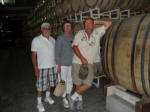 | Back at the marina, we made arrangements for the next day of fun. We chartered a van and driver to take us to wine country. Yes! has a wine country and it is actually just a few miles south of the Valle Guadalupe is home to a couple dozen vineyards and wineries, many of them very good. The oldest, and easily the largest, of these is L.A. Cetto founded in the early 20th century. We have drunk their wines many times before and were excited to tour the winery and participate in a tasting.  | ||||||||||||||
| |||||||||||||||
Wednesday, October 20, 2010
These Callos (Scallops) are fresh!
After a particularly long run of WORK, with almost no days off since July Fourth, Bob and I decided on a much needed few days rest in Mexico. I know what you're thinking, "too damn dangerous"! Maybe so, but it was also very much worth it! After a leisurely breakfast overlooking the ocean at Manny's in Puerto Penasco, we ventured on south to el Desemboque. (one of two towns with the same name within fifty miles of one another) a tiny fishing village on the Sea of Cortez. "Our" little town is on the desolate, and spectacular, desert west coast of Sonora, our neighboring state south of Arizona. We had had a rough night before, so we went straight to our motel. It's the only one in town, very cute and clean. Our room faced the ocean and the views were spectacular! We immediately placed our reclining lawn chairs on the veranda, mixed drinks and commenced keeping a close watch over the sea. (Just in case something happened.) We were fortunate to arrive at our destination when the moon was in a quarter phase which means the tides were right for harvesting the callos. (Scallops to us) We watched, over coffee, each morning as the pangas raced to a spot about three or four miles out. We could see them well with our super binoculars as they lined up on the horizon and deployed the divers. By early afternoon the boats would come speeding back to us, laden with their catch. The shells of the scallops would be clearly visible, piled high above the sides of the pangas as they sat very low in the water.
+of+launching_a_panga_zoom_small.jpg) The launcheros would get busy hauling the boats from the water as fast as they could and take each one the the captain's home. Most would be slid from the trailer to a spot on the ground under a shade tree. At that point, a crowd would gather and the frenzied work of shucking would begin. Soon, the large pile of callos in the boat would become a large pile of shells on the ground. Buckets would abound with the freshly harvested, meaty adductor muscles of these delicious sea mollusks. Children would move the meat morsels around in the sand, then men would rinse them by swishing them vigorously in big tubs of sea water. The work is grueling and only finished for
The launcheros would get busy hauling the boats from the water as fast as they could and take each one the the captain's home. Most would be slid from the trailer to a spot on the ground under a shade tree. At that point, a crowd would gather and the frenzied work of shucking would begin. Soon, the large pile of callos in the boat would become a large pile of shells on the ground. Buckets would abound with the freshly harvested, meaty adductor muscles of these delicious sea mollusks. Children would move the meat morsels around in the sand, then men would rinse them by swishing them vigorously in big tubs of sea water. The work is grueling and only finished forthe day after the last scallop has been shucked, weighed and bagged to sell. At sunrise the next morning the entire cycle begins again.
We knew we would never find fresher scallops than these, (nor pescadores who needed the income worse). Bob set out walking from boat to boat along the beach to negotiate for the delicacy. This is one of his favorite things to do. His Spanish is lousy and few of the sellers spoke English. It doesn't seem to matter to anyone. They laugh and slap each other on the shoulders and make the deal. Everyone is happy and we get to bring home some fabulous seafood from one of our favorite locales! bon appetit!
Friday, August 20, 2010
I think August is about our most miserable month. It is hot as hell and the monsoons are upon us. Humidity is UP and patience is down. On the days we have one of our wondrous thunderstorms, we are reminded of one of the many reasons we live here. Other days it is merely a blast furnace with humidity. Not something we desert rats enjoy! But....
The gardens! I am being shown how good an idea it was to really cram everything close together. I do have to search many times, for the tasty booty hidden within, but I am convinced that by crowding it creates a micro climate that benefits the plants. One plant shades another and they all shade the ground beneath. I still have to water everyday or the plants become wilted and stressed. I am discovering though, that good and diligent care through these roughest of times will pay off in the fall. While many gardener's tomato plants are dried and crispy, never to see another fruit, mine are hanging in there and will be producing again soon. In fact, I am beginning to find some tomatoes here and there already! As our weather cools over the next few months the tomatoes and peppers will flourish once again! The onions have all matured and it's time to plant more of them. I am readying another little garden space on the west side of the yard and plan to plant artichokes and some other "winter" crops there. Wish me luck.
The amount of water used to keep everything alive has been significant. But given the quality of produce we have gotten (with no fears of any dreaded diseases brought on by contamination) we are ready to continue planting year round. We love the opportunity to provide fresh, wholesome veggies and herbs in our cooking classes and we are convinced the health benefit and value of the increased flavor and freshness of the produce is priceless for ourselves and our students .
Chow!
The gardens! I am being shown how good an idea it was to really cram everything close together. I do have to search many times, for the tasty booty hidden within, but I am convinced that by crowding it creates a micro climate that benefits the plants. One plant shades another and they all shade the ground beneath. I still have to water everyday or the plants become wilted and stressed. I am discovering though, that good and diligent care through these roughest of times will pay off in the fall. While many gardener's tomato plants are dried and crispy, never to see another fruit, mine are hanging in there and will be producing again soon. In fact, I am beginning to find some tomatoes here and there already! As our weather cools over the next few months the tomatoes and peppers will flourish once again! The onions have all matured and it's time to plant more of them. I am readying another little garden space on the west side of the yard and plan to plant artichokes and some other "winter" crops there. Wish me luck.
The amount of water used to keep everything alive has been significant. But given the quality of produce we have gotten (with no fears of any dreaded diseases brought on by contamination) we are ready to continue planting year round. We love the opportunity to provide fresh, wholesome veggies and herbs in our cooking classes and we are convinced the health benefit and value of the increased flavor and freshness of the produce is priceless for ourselves and our students .
Chow!
Thursday, June 17, 2010
Have your landscape (and eat it too!)

Here it is, mid June. Gardening in Tucson is soon to become a sort of hell. Don't get me wrong, this doesn't mean it isn't worth it. This simply means, with our heat, you fight with the devil himself for your plants! Right now, our gardens are really vigorous. Fruit is ripening everywhere. Just a few minutes ago I picked some cherry tomatoes, a huge Japanese Eggplant and a beautiful yellow Banana Pepper. I simply ate the one strawberry I found without bothering to take it into the house. Our plants are just beginning to mature and the rewards are just around the corner! Chiles! We have about eight or ten different varieties from the "World's Hottest" to some nice tasty but mild ones. I can't wait for the fresh salsa. I am sure we will can or freeze a lot of our harvest for later use. Tomatoes! Wow, we planted probably a dozen varieties of them. Lots of the usual kinds, just to make sure we have plenty of wonderful, tasty, REAL, tomatoes. I picked a few of our first Celebrity tomatoes from our vines the other day. They absolutely blasted us with flavor! The Early Girl vines are loaded with nice big green, orbs that are tantalizingly close becoming ingredients in our cooking class recipes. Our Roma tomatoes will be mostly used for paste and are coming along little later than the others. We also planted a number of endangered heirloom tomato plants. These are mostly indigenous to the desert southwest and Mexico. I even was able to acquire and plant some heirloom tomatoes from France given by a friend who "discovered some seeds had somehow become stowaways and made the trip home with him." Several of the heirloom plants are a little happier than others but we have some great looking fruit on some of those too. I am really excited to taste these and see which we like best. Of course, those will be chosen as candidates for next year's gardens. There are many other choices while browsing among our plants; onions, (I've been grilling them and they are fantastic!) baby carrots, fennel, and so many different herbs, it's hard to mention them all. There are squash and cucumbers and artichokes and Leeks. I let some of the onions go to seed so their beautiful puffball flowers stand sentry over the other plants. About that title.... Here is the bottom line; we live in the desert and it is very tempting to grow some grass, plant some wonderful looking, water guzzling, leafy landscape plants and have a beautiful yard. Just like back home. You will work your butt off to admire something that just does not belong here. One other alternative is Xeriscape. A sort of water miser, barren, cactus studded.......area. UGH! Don't take this the wrong way. I know, I know, our water is precious and in short supply...and expensive. I just think there is a wonderful compromise. In fact I think this is better than a compromise for a number of reasons. So, if you want to have beautiful landscaping (and eat it too)... Here is what you do. Plant a garden! Go to your favorite nursery or Home Depot, Lowes, hell.. even Wal-Mart and buy some plants you would like to eat. Prepare your area. ( it doesn't have to be very big) You are not starting a farm, you're only planting some stuff you like. Three feet by eight feet of space will grow a lot of veggies. I have about five different spaces this size arranged around our yard. This is a manageable size and you will be able to reach in to the middle to harvest. You can plant directly in the ground or create raised beds. I have both. Dig down about six to ten inches and turn the soil. Take your time and enjoy, you don't even have to do this all at once. Use some of the soil to build little berms around your garden space. This will help keep your watering where it belongs. Add some dry composted horse or cow manure (usually free on Craig's list, I got six cubic yards delivered for free!) and some garden compost to your existing soil mixture and turn it to mix evenly. I use about one third of each. Now, among your veggies, plant a few colorful flowers. Petunias and marigolds are great. They look pretty and chase off pests. You can add stock or daisies for a little height. It's a win, win. Your garden will naturally use more water than the arid type landscapes we see here so often. But, you are now growing edibles and not just grass and decorative plants. Hey, someone somewhere is growing, and watering the veggies you eat anyway. And, God only knows what chemicals they are putting on their crops, (your food) but you will know exactly what went on yours, won't you? No longer will you be paying a fortune for "hothouse grown" "vine ripened" tasteless tomatoes. Yours will be bursting with flavor and healthy vitamins and all that other good stuff. Walk out the door and pull a few onions for tonight's spaghetti sauce from your own garden. Snip some homegrown oregano and a little thyme. Wow! You are going to feast! Many of the herbs will grow year round here and most of the other things will need to be replaced with your next crop. With a little planning, and not a lot of work, (honest) you will have a beautiful, edible, landscape. This time of year you may have to water everyday or even twice if it's windy. But. You won't need to worry about e-coli or any of those other pesky critters that can make people sick, or can even kill us. The water you use will have been used somewhere on your food anyway but now you will reap the rewards of wonderful, tasty and wholesome vegetables and herbs. Go ahead.......eat your landscape! From our Newsletter; BiteMe on www.CuisineClassique.com
Monday, February 1, 2010
Heirloom Tomatoes in Tucson
Last week I came upon a post on Craig's List. It was for organically grown Heirloom Tomato plants! Of course, I was excited, since I try to grow most of our veggies and nearly all our herbs for our cooking classes. Heirlooms! These are not only part of our heritage and many times indigenous to one's local area, they also have not been ruined by genetic messing. Here they are, natural, and real. Real flavor, real seasons, and.....real seeds to keep your plants growing year after year. Their website link is: http://www.aravaipa.com
The actual farm is north of Tucson but you can order your starts online to be picked up either in Oracle, Arizona in early March, or at the Santa Cruz River Farmers' Market on Speedway in Tucson.
I can't wait to order a selection for my gardens. I plan to get about six varieties (they have 33!) choosing from the ones that have a local connection or are great producers. I love the idea of having pieces of history growing in my gardens. Being able to eat the results, priceless!
The actual farm is north of Tucson but you can order your starts online to be picked up either in Oracle, Arizona in early March, or at the Santa Cruz River Farmers' Market on Speedway in Tucson.
I can't wait to order a selection for my gardens. I plan to get about six varieties (they have 33!) choosing from the ones that have a local connection or are great producers. I love the idea of having pieces of history growing in my gardens. Being able to eat the results, priceless!
Friday, January 29, 2010
The Truth About "Organic" Food Labels
ORGANIC
We have all seen this designation on the foods we purchase.
Often, this is a determining factor in choosing one product
over another.
Well, "Not so fast my friend!".
The ubiquitous USDA "ORGANIC"seal so prominently
displayed on many products, WITHOUT the words,
"100% ORGANIC" only means; at least 95% of the
content, by weight, is organic. Oh, (excluding water
and salt). The remaining five percent of ingredients
is on an approved list of non-agricultural products
not available in organic form. Products are certified
(usually by a third party) and, here is the good news,
may not include using methods such as sewage sludge
and ionizing radiation.
WARNING THIS IS GRAPHIC!
YUCK
To be truly organically grown (and minimally processed),
our food must have been produced without conventional
pesticides, artificial fertilizers, human waste, sewer sludge,
ionizing radiation, genetic engineering, or food additives.
Sweet!
To be certified as organic, livestock cannot be grown with
the use of growth hormones nor the routine use of antibiotics.
There is a lot more information beneath this surface layer
I am providing. The process to have one's produce
or animals CERTIFIED as "ORGANIC" has become so
expensive that it is prohibitive to many small farms.
HMMMM.... interesting.
Now, this does not mean theese small farms are not producing
perfectly wholesome food. On the contrary, most small family
farms do care about their products and cultivate in a responsible
way. They just cannot SAY it is "ORGANIC" because they
didn't pay the (sometimes $10,000) fee to have it certified by
USDA. When shopping, we try to look for other "codewords"
such as naturally grown, etc. It is also helpful to shop when you
can, at local farmer's markets. There, you will be able to meet
and talk to the actual grower. Join a CSA. It hardly matters
where you live, you will be able to find small family owned
farms and gardens that are eager to share their bounty!
Of course, you're not going to drop dead from eating less
than 100% organic food all the time. But, given the (real)
choice, you may want to eat in as natural and wholesome
way as you can. The bottom line is this: In the supermarkets
etc, it isn't really organic unless it says "100% ORGANIC".
We call the rest of that stuff "Organish"
Chow!
Subscribe to:
Posts (Atom)

